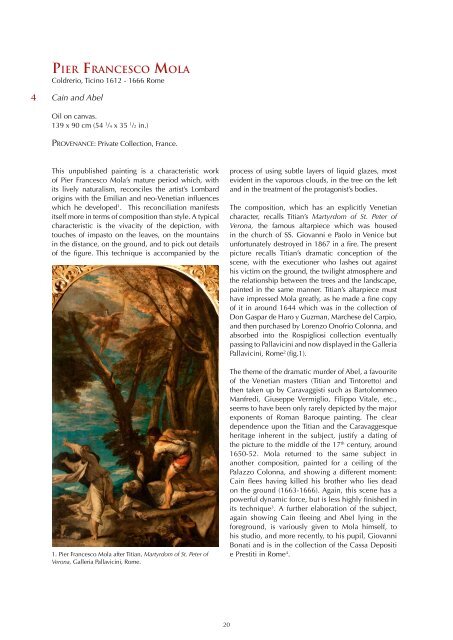You also want an ePaper? Increase the reach of your titles
YUMPU automatically turns print PDFs into web optimized ePapers that Google loves.
Pier Francesco Mola<br />
Coldrerio, Ticino 1612 - 1666 Rome<br />
4<br />
Cain and Abel<br />
Oil on canvas.<br />
139 x 90 cm (54 3 /4 x 35 1 /2 in.)<br />
Provenance: Private Collection, France.<br />
This unpublished painting is a characteristic work<br />
of Pier Francesco Mola’s mature period which, with<br />
its lively naturalism, reconciles the artist’s Lombard<br />
origins with the Emilian and neo-Venetian influences<br />
which he developed 1 . This reconciliation manifests<br />
itself more in terms of composition than style. A typical<br />
characteristic is the vivacity of the depiction, with<br />
touches of impasto on the leaves, on the mountains<br />
in the distance, on the ground, and to pick out details<br />
of the figure. This technique is accompanied by the<br />
1. Pier Francesco Mola after Titian, Martyrdom of St. Peter of<br />
Verona, Galleria Pallavicini, Rome.<br />
process of using subtle layers of liquid glazes, most<br />
evident in the vaporous clouds, in the tree on the left<br />
and in the treatment of the protagonist’s bodies.<br />
The composition, which has an explicitly Venetian<br />
character, recalls Titian’s Martyrdom of St. Peter of<br />
Verona, the famous altarpiece which was housed<br />
in the church of SS. Giovanni e Paolo in Venice but<br />
unfortunately destroyed in 1867 in a fire. The present<br />
picture recalls Titian’s dramatic conception of the<br />
scene, with the executioner who lashes out against<br />
his victim on the ground, the twilight atmosphere and<br />
the relationship between the trees and the landscape,<br />
painted in the same manner. Titian’s altarpiece must<br />
have impressed Mola greatly, as he made a fine copy<br />
of it in around 1644 which was in the collection of<br />
Don Gaspar de Haro y Guzman, Marchese del Carpio,<br />
and then purchased by Lorenzo Onofrio Colonna, and<br />
absorbed into the Rospigliosi collection eventually<br />
passing to Pallavicini and now displayed in the Galleria<br />
Pallavicini, Rome 2 (fig.1).<br />
The theme of the dramatic murder of Abel, a favourite<br />
of the Venetian masters (Titian and Tintoretto) and<br />
then taken up by Caravaggisti such as Bartolommeo<br />
Manfredi, Giuseppe Vermiglio, Filippo Vitale, etc.,<br />
seems to have been only rarely depicted by the major<br />
exponents of Roman Baroque painting. The clear<br />
dependence upon the Titian and the Caravaggesque<br />
heritage inherent in the subject, justify a dating of<br />
the picture to the middle of the 17 th century, around<br />
1650-52. Mola returned to the same subject in<br />
another composition, painted for a ceiling of the<br />
Palazzo Colonna, and showing a different moment:<br />
Cain flees having killed his brother who lies dead<br />
on the ground (1663-1666). Again, this scene has a<br />
powerful dynamic force, but is less highly finished in<br />
its technique 3 . A further elaboration of the subject,<br />
again showing Cain fleeing and Abel lying in the<br />
foreground, is variously given to Mola himself, to<br />
his studio, and more recently, to his pupil, Giovanni<br />
Bonati and is in the collection of the Cassa Depositi<br />
e Prestiti in Rome 4 .<br />
20
















